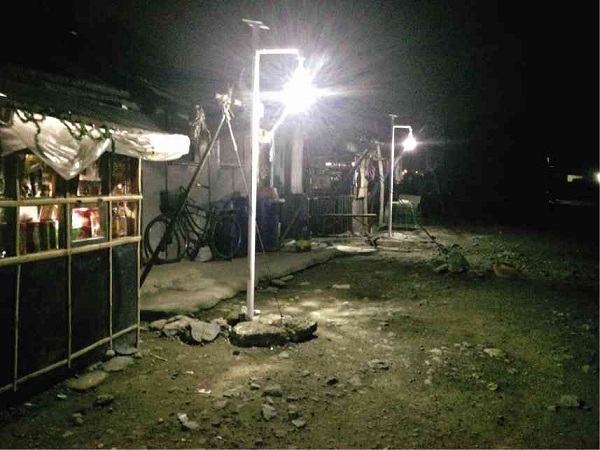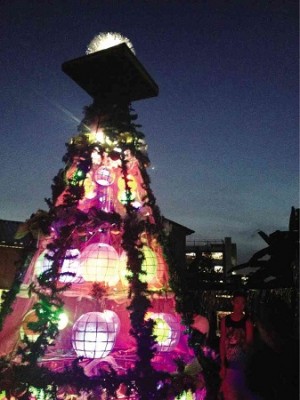It’s (not) just another New Year’s Eve

THE LED-powered street lights are transforming the lifestyle of residents in Dampalit. They no longer need to hide inside their houses at night for fear of being victimized by criminals.
A small fishing community and a group of shanty dwellers in Malabon City are saying goodbye to candlelight dinners and looking forward to a bright New Year ahead after receiving the gift of solar-powered lights.
In the villages of Catmon and Dampalit in Malabon, residents now wait eagerly for the sun to set unlike countless other times when they dread the coming of night.
In Catmon, residents gather around a small and makeshift courtyard. Around them are several pom-poms made out of discarded and shredded bottles of mineral water. In the middle of the open space stands a 10-foot Christmas tree made from cheap green tinsel garlands and studded with Christmas balls the size of a small basketball.

A CHRISTMAS tree (lower photo) with LED-powered lights and pom-poms made from discarded water bottles literally light up the lives of 100 families in Dampalit and Catmon in Malabon City. The families are the happy beneficiaries of a solar power project. PHOTOS BY NATHANIEL MELICAN
In Kamalig, Road 4, Dampalit, the 30 or so families living in the middle of fishponds are either in their houses looking up at the newly-fitted softdrink bottles on their roofs or gathered outside examining improvised lampposts equipped with the same softdrink bottles.
All these fixtures and decorations—the pom-poms, the Christmas balls and the softdrink bottles on the roofs and on lampposts—are fitted with light-emitting diodes (LEDs) which are just waiting for the right time to light up.
Article continues after this advertisementAs the sky grows darker, the first of the lights in the pom-poms, Christmas tree and softdrink bottles light up and the residents let out a collective “wow” in delight and amazement. More and more of the lights light up as the night continues to fall.
Article continues after this advertisementSolar power
These LEDs are not powered by electricity provided by the Manila Electric Co. Instead, these run on solar panels that charge its batteries for most of the day.
The “solar lights” are the project of the My Shelter Foundation’s A Liter of Light program started by Filipino social entrepreneur Illac Diaz in partnership with the Malabon City government.
Some 30 households in Dampalit and 70 more in Catmon are the first to experience the solar lights.

A CHRISTMAS tree (lower photo) with LED-powered lights and pom-poms made from discarded water bottles literally light up the lives of 100 families in Dampalit and Catmon in Malabon City. The families are the happy beneficiaries of a solar power project. PHOTOS BY NATHANIEL MELICAN
“Our aim is not just to give the gift of light to the residents but also to teach them how to make these lights so that they can hopefully earn a living from it. This is not just a lighting project but also a grassroots livelihood program,” Diaz said. My Shelter Foundation has also brought the project to Tacloban, Cebu and Bohol, areas recently affected by Supertyphoon “Yolanda” and a powerful earthquake.
Malabon Mayor Antolin Oreta III says the city government picked the two villages for the implementation of the project to serve residents who have been using candles and gas lamps to light up their nights for most of their lives.
“All of the beneficiaries here are poor people who really need light and a source of income. This is a big thing for them because they will have a safe light source while not facing the risk of being arrested for tapping into power lines or not having to pay an electricity bill. And they get to learn how to build these lights as well,” Oreta adds.
Rikki Macolor, a graduating electronics and communications engineering student of the University of Santo Tomas who invented the solar light and proposed it to the My Shelter Foundation, explains that the circuit is simple enough to build. The LEDs are attached to a circuit that includes a solar panel no bigger than a cell phone and about as thick as a credit card and a small battery specially designed to take in current generated by the solar panel.
“The beauty about this circuit is that it is modular. One basic circuit can power a house but if you join three of these circuits together, you can power a basic street lamp,” Macolor, who is now also volunteering for the My Shelter Foundation, says.
During the day, the solar panel charges the battery. When night falls, the light automatically switches on. The light turns off when morning comes and the process repeats it. The solar panels can last well over a decade while the battery needs replacing every three to five years. Macolor tells the Inquirer that while the parts seem difficult to find, these can be bought in Raon in Quiapo and other major electronics stores.
“We put a lot of thought into the materials we used so that communities over the Philippines can really make this livelihood sustainable. This simple circuit costs us about P750 to build right now but because we are hoping that more and more people will get into this program, we expect the price to go down to just P500,” Macolor adds.
For Dampalit residents especially, the solar lights are making a major change in their lifestyle. The community sits in the middle of fishponds and salt-making ponds and is accessible from the main road only through a dirt road which is plunged into darkness every time night falls.
“It’s been difficult living without electricity here,” says 24-year-old mother Lean Lara who also maintains a sari-sari (retail) store in the community. “Our nights end early and it’s always scary if you need to go out at night or if you have to fetch someone from the main road what with crimes happening everywhere. Our dirt road here did not have street lights before today.”
Edna Nava, a 40-year-old cook who has lived in the community in her entire life, agrees. “Before, we would use a gas lamp and after dinner, we had to turn the light off to make it last longer,” she says.
“Now we can walk confidently on the dirt road at night because we can see the way and if there are persons coming. The children can play outside for a longer period. We can do so much more now,” she adds.
Nava says she is excited at the prospect of spending the New Year’s Eve celebration under the LED lights.
“We used to gather outside around a small light to celebrate the coming of Christmas and New Year. But thanks to the LED street lights, we have better light,” she tells the Inquirer, adding: “But for tonight, I think we’ll sleep a bit late and just stare at our new light.”